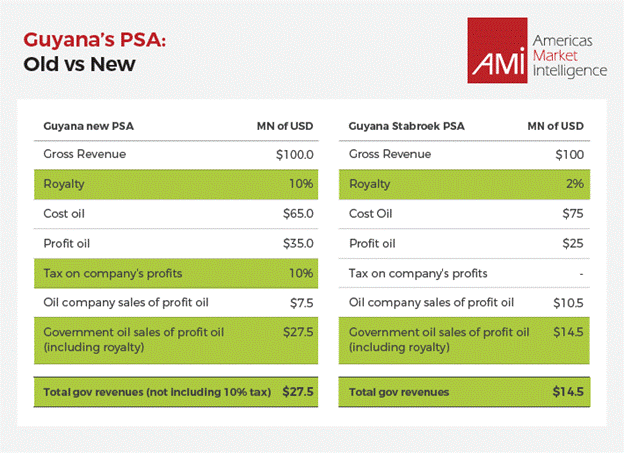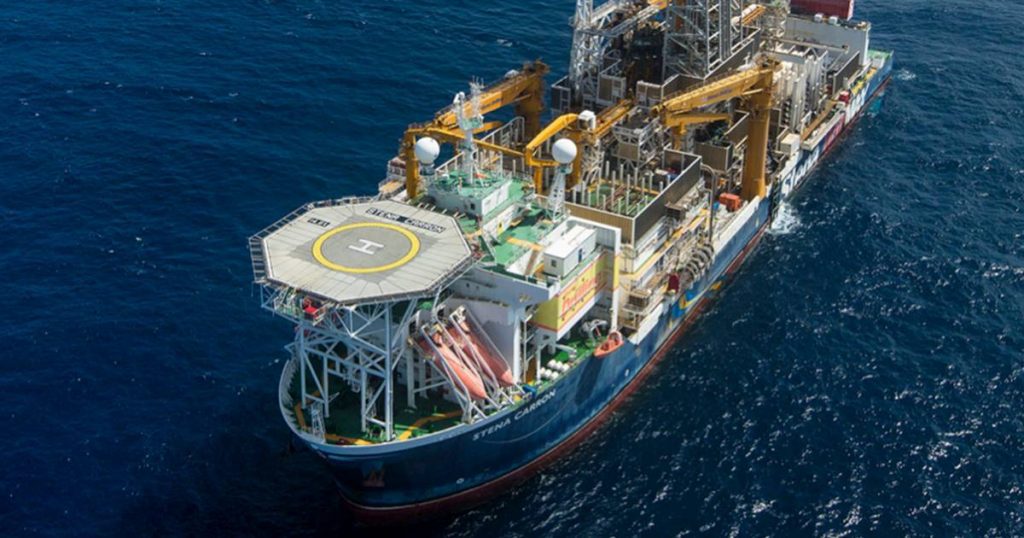By Arthur Deakin
News Americas, WASHINGTON, D.C., Fri. April 14, 2023: Within months, Guyana is expected to have auctioned 14 different oil blocks surrounding the biggest offshore oil discovery in the last decade. The government has announced that there could be 25 billion barrels of oil equivalent within those blocks, equivalent to nearly 60% of proven U.S. oil supplies. Big oil, such as Shell, Chevron, Petrobras, and ExxonMobil, have paid for seismic data in anticipation of a potential bid.
Their participation will depend on the newly revised Production Sharing Agreement (PSA), which is stipulated to increase the government’s initial share of oil revenues from 14% to 27% (plus 10% income tax). Other decisive factors, including a potential 50% farmout of the awarded acreage after three years of seismic testing, are yet to be determined.

Graph 1: How much will a U$100 million oil lift generate in revenues for Guyana?
Separate from this auction, Vice President Bharrat Jagdeo is also considering negotiating blocks directly with oil companies located in Qatar, Britain, the United Arab Emirates, and India. Having two different award mechanisms, one for private and one for public companies, can cause uncertainty and jealousy in the market as different terms are offered to different types of players. Government-to-government negotiations are often done behind closed doors, leaving little room for accountability. Further clarity on what companies should expect, both from the PSA and the bilateral negotiations, will help assuage market concerns.
It is no secret that ExxonMobil, Hess and CNOOC (Stabroek Consortium) have seen extraordinary commercial success in the Stabroek Block since 2015. Crafted in 2015, the government’s initial PSA allowed upstream players to recover up to 75% of their exploration cost if they struck “gold”, de-risking the Stabroek Block’s financial burden. This is exactly what happened. While the global average of successful offshore exploration wells stood at 25% in 2020, the Stabroek Consortium has seen an exploration success rate of 90%. Although the success has been constant, wells are increasingly being drilled in more complex, more costly, and less promising areas within the Stabroek Block. These success rates will almost certainly drop.
In fact, in neighboring Brazil´s pre-salt area, Petrobras’ nearly 100% exploration success rate in the early 2010s has fallen to the 25% levels seen across the industry. During the 2010s, Shell and ExxonMobil sank nearly US$4 billion dollars in Brazilian exploration and failed to come up with significant commercial discoveries. In April 2023, ExxonMobil announced it would quit drilling in Brazil.
The surrounding blocks in Guyana have also seen very limited success, with commercial quantities discovered in only one well outside the Stabroek Block (Kawa-1 well in the Corentyne Block). This is despite significant exploration efforts and large investments being made by upstream players such as CGX and Repsol, who have failed to see a pay-out. The potential in Guyana is enormous, but it is likely that many oil companies will come out empty-handed.
In addition to close analysis of the seismic data, companies seeking to position themselves favorably to win this tender need to establish good relationships with both the public and the private sector in Guyana. In a country with less than 800,000 people, where power is concentrated in the hands of a few, being well-connected is of paramount importance.
Unlike auctions in Brazil, where the signing bonus and cost oil vary by block, Guyana has set a fixed US$10 million signing bonus for its shallow blocks and US$20 million for the more attractive deep-water fields. As such, companies won’t be able to offer the government a higher percentage of profit oil in their bids, but they can include certain incentives within their bids to increase their chances of being selected. One option is to provide guarantees of socially or environmentally impactful investments in local communities with a percentage of the profit oil. Another option is to form a bidding consortium that is extremely well capitalized, diverse, and experienced, creating leverage for the Guyanese government which seeks to reduce its dependence on the Stabroek consortium. A third idea would be to offer accelerated payment conditions to increase the governments´ access to liquidity.
Another important factor to include in the bid is a work program that abides by local content rules. In this work program, bidders should have milestones that show their inclusion of local employees in relevant services. This is especially important within the 14 different local content categories that require between 90 to 100% local staff, ranging from catering to ground transportation.
Halliburton, Schlumberger, and other multinationals that now have local offices in Guyana and are seeking to win contracts from the winners of the auction, must also ensure their local content requisites are covered. In fact, a local content certificate awards suppliers a 5% boost in their score when being evaluated by contractors, complemented by a strong financial standing, and proven technical expertise. The Ramps Logistics controversy shows that any discrepancies in paperwork can lead to legal challenges by the Local Content Secretariat, although the court denied any wrongdoing by Ramps and ultimately awarded their certificate.
It is also important to reflect on previous tenders to forecast what to expect in Guyana. In Guyana, the two winners of the marketing contracts related to the government’s share of profit oil were awarded to the lowest compliant bids in 2021* and 2022. This reflects that bidders must position their bids as the most profitable option for Guyana vis-à-vis their peers, using investment guarantees and incorporating work programs that encourage local economic opportunities.
*For 2021, the lowest bidder was Chinese company Sinochem, at 0.02 cents/b, but the lowest compliant evaluated bidder was Saudi Aramco’s trading arm ATL.*
EDITOR’S NOTE: Arthur Deakin is the Director of the Energy Practice at AMI (Americas Market Intelligence), where he helps companies expand into Guyana and the wider Latin American region through market research and strategic analysis. In the past 10 years, AMI has helped companies understand the Guyanese market, navigate Guyana’s local content legislation, and position themselves to win new contracts.







